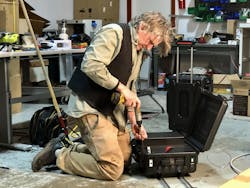These 2 organizations acted quickly to provide solar microgrids to Ukraine
“We have to do something,” Will Heegaard, operations manager for Footprint Project — a nonprofit that provides solar microgrids and other emergency power systems to disaster areas — told Paul Shmotolokha just hours after Russia launched its invasion of Ukraine on Feb. 24.
Heegaard and Shmotolokha — a Ukrainian-American and CEO of New Use Energy — are no strangers to disaster. New Use Energy provides solar microgrids, solar headlamps, humanitarian aid and other products to regions hit by hurricanes and other crises, often supplying emergency power systems to Footprint Project. With the help of New Use Energy and others, Footprint Project has jumped into action to provide solar generators for communities affected by Hurricane Ida, for desperate Texans during the state’s February 2021 deep freeze and other crises.
But Ukraine was a whole new world for the pair, who have only operated abroad a few times.
“Will called me at 7 a.m. after the war started,” said Shmotolokha, whose wife was born in Ukraine. “Will and I knew this would be very big.”
Very big indeed were the challenges the pair faced, including attracting funding, shipping units classified as hazardous materials and finding trusted sources in Europe to provide equipment.
They got to work developing a coalition of non-profit, government and corporate partners. Global Empowerment Mission and SmartAid, both global relief organizations, stepped up to bolster the effort, and Shmotolokha’s friends and family in the region offered critical insight into needs on the ground.
Serving refugees and hospitals
That morning, the pair developed a plan to send solar microgrids to Ukrainian hospitals and emergency power equipment to a refugee camp in neighboring Moldova. In these areas, grid power is generally not available because of the war’s devastation. (PowerOutage.com has begun tracking grid outages in Ukraine.) Gas- and diesel-fired generators are being used as backup power, spewing pollution and noise. What’s more, it’s difficult and dangerous to acquire fuels for the backup generators, said Shmotolokha.
The solar generators are especially helpful in refugee camps, where they offer a quieter and cleaner alternative to fossil fuel generators, which can undermine the mental and physical health of refugees suffering from post-traumatic stress disorder, according to Shmotolokha. Solar generators are also essential in medical facilities, where they can provide clean energy to staff members needing electricity for light, communications gear and life-saving equipment.
This week, Footprint Project and New Use Energy sent six pallets of portable solar microgrid equipment to Ukraine to power medical lighting and communications equipment. The two organizations are also sending to medical facilities 120 small portable power stations — handheld units that include batteries and an inverter. Thanks to a $25,000 matching grant from Mac6–which provides co-working space for businesses, Footprint Project is preparing follow-up initiatives for the region in the coming weeks and months.
Save the date for ‘Microgrid 2023: Lights On!’ May 16-17 in Anaheim, California
A separate shipment from Global Empowerment Mission and SmartAid included 64 surgical headlamps for use in hospitals. And yet another included handheld solar lighting solutions and connectivity hardware.
Heegaard and Shmotolokha have a bigger vision for helping Ukraine — and, eventually, other countries — during disasters and wars. They want to train local people to assemble and maintain the solar microgrids and emergency power systems, which, in this case, will employ Ukrainians and get the microgrids on the ground more quickly.
“It’s exciting,” said Heegaard. “This pilot could offer a unique model of how to do disaster power. We send stuff initially and get partnerships worked out so we can build there and train a local workforce to assemble and service equipment. We’re not just dropping off solar generators. This is much more a solution about how to train, use, build and maintain the generators.”
For now, Footprint Project and New Use Energy are delivering flexible portable power stations, solar microgrids and humanitarian aid to Ukraine and Moldova, working with a host of other organizations. Most of the equipment comes from the US; some of it from Europe.
Wartime value of solar
The equipment is especially well suited to wartime use, said Shmotolokha.
The solar generators range in size from checked luggage to a dishwasher, with solar panels that look like a throw rug. The power stations range from a brick to a briefcase.
“They can charge outside and be wheeled inside and outside,” he said. “They are highly tactical, there’s no glass or frame. They are lightweight and flat. You can fold them up or charge them on the ground,” he said. Their mobility allows owners to react to one crisis, then move onto another. “As the needs shift, we can shift along with them,” he said. “A lot of that’s doable because we put the equipment on wheels. And I can tuck the 300-watt solar panels under my arm.”
Footprint Project has been able to take action in Ukraine and Moldova thanks to Shmotolokha’s and his wife’s contacts in Ukraine, including people at a children’s hospital in Ukraine and a former co-worker of Shmotolokha in Moldova. Those contacts have helped identify hospitals’ needs, made connections and have accepted deliveries of equipment.
New Use Energy has plans to build 100 portable solar microgrids and portable power stations for SmartAID — a disaster relief organization — and Footprint Project. They’ll be shipped to hospitals and used for backup power for critical communications, according to Shmotolokha. The organizations are now seeking funding for that effort.
The portable power stations will also provide power for ambulances and first responders.
Free shipping from the US to Ukraine and Moldova is being provided by AirLink, a nonprofit air shipment partner that worked with New Use Energy to solve the challenge of getting lithium-ion batteries – labeled as hazardous – sent overseas.
Trying to assemble in Ukraine
After the pallets of solar microgrid equipment are delivered this week, the next step is to begin assembling generators in Ukraine, which will provide jobs and clean energy workforce education, said Heegaard.
Using Shmotolokha’s contacts, the two organizations are working to source more equipment in Europe for assembly in Ukraine. But the challenge is ensuring the suppliers can be trusted.
“It’s so critical to have a chain of command between where the equipment is coming from and who is plugging it in on the front line. It’s critical to any humanitarian mission — making sure the equipment doesn’t become party to the conflict,” said Heegaard.
The nonprofit organizations’ initial efforts were met with gratitude from one hospital’s staff, said Tatiana Terdal, a board member of the Ukrainian-American Cultural Association of Oregon and Southwest Washington. For years Terdal has helped the community connect with Medical Teams International, sending containers of medical supplies to Ukraine.
“I contacted people I know at the hospital to see if they could give me feedback on the solar headlamps. They said, ‘The lamps are super, surgeons are happy.’”
The long view
Meanwhile, equipping humanitarian responders with solar microgrids and other emergency response power equipment can set the stage for delivering electricity in new ways, said Heegaard. Much of the power grid, now destroyed, will have to be rebuilt, and it can be built with renewables.
“Ukraine obviously wants to use as little fuel as possible. This will spur more transformation toward renewables,” said Heegaard. “It’s a long road and it won’t happen overnight.”
Several non-profits are participating in the Ukraine effort, including SmartAid, which funded portable power stations, generators, logistics and coordination; Global Empowerment Mission, which funded surgical lights and portable power stations; Lifting Hands International, which paid for a solar trailer for Moldova; Information Technology Disaster Resource Center, which provides communications equipment; Moldova World Children’s Fund, a local implementing partner in Moldova; Amurtel, which purchased lights, and United to Light, which donated solar reading lanterns. In addition to New Use Energy, for-profit suppliers include Enova Illumination, which provided surgical headlamps, MPowered, which provided solar laterns, Sunstream, which built solar trainers for Moldova, and Skoon, which supplied solar generators.
Track news about solar microgrids in disaster areas. Subscribe to the free Microgrid Knowledge Newsletter.








